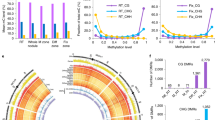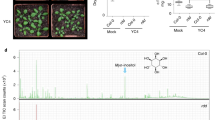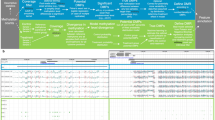Abstract
The legume–Rhizobium symbiosis leads to the formation of a new organ, the root nodule, involving coordinated and massive induction of specific genes. Several genes controlling DNA methylation are spatially regulated within the Medicago truncatula nodule, notably the demethylase gene, DEMETER (DME), which is mostly expressed in the differentiation zone. Here, we show that MtDME is essential for nodule development and regulates the expression of 1,425 genes, some of which are critical for plant and bacterial cell differentiation. Bisulphite sequencing coupled to genomic capture enabled the identification of 474 regions that are differentially methylated during nodule development, including nodule-specific cysteine-rich peptide genes. Decreasing DME expression by RNA interference led to hypermethylation and concomitant downregulation of 400 genes, most of them associated with nodule differentiation. Massive reprogramming of gene expression through DNA demethylation is a new epigenetic mechanism controlling a key stage of indeterminate nodule organogenesis during symbiotic interactions.
This is a preview of subscription content, access via your institution
Access options
Subscribe to this journal
Receive 12 digital issues and online access to articles
$119.00 per year
only $9.92 per issue
Buy this article
- Purchase on Springer Link
- Instant access to full article PDF
Prices may be subject to local taxes which are calculated during checkout






Similar content being viewed by others
References
Vasse, J., de Billy, F., Camut, S. & Truchet, G. Correlation between ultrastructural differentiation of bacteroids and nitrogen fixation in alfalfa nodules. J. Bacteriol. 172, 4295–4306 (1990).
Kondorosi, E., Mergaert, P. & Kereszt, A. A paradigm for endosymbiotic life: cell differentiation of Rhizobium bacteria provoked by host plant factors. Annu. Rev. Microbiol. 67, 611–628 (2013).
Maunoury, N. et al. Differentiation of symbiotic cells and endosymbionts in Medicago truncatula nodulation are coupled to two transcriptome-switches. PLoS ONE 5, e9519 (2010).
Limpens, E. et al. Cell- and tissue-specific transcriptome analyses of Medicago truncatula root nodules. PLoS ONE 8, e64377 (2013).
Roux, B. et al. An integrated analysis of plant and bacterial gene expression in symbiotic root nodules using laser-capture microdissection coupled to RNA sequencing. Plant J. 77, 817–837 (2014).
Mergaert, P. et al. A novel family in Medicago truncatula consisting of more than 300 nodule-specific genes coding for small, secreted polypeptides with conserved cysteine motifs. Plant Physiol. 132, 161–173 (2003).
Alunni, B. et al. Genomic organization and evolutionary insights on GRP and NCR genes, two large nodule-specific gene families in Medicago truncatula. Mol. Plant Microbe. Interact. 20, 1138–1148 (2007).
Durgo, H. et al. Identification of nodule-specific cysteine-rich plant peptides in endosymbiotic bacteria. Proteomics 15, 2291–2295 (2015).
Wang, D. et al. A nodule-specific protein secretory pathway required for nitrogen-fixing symbiosis. Science 327, 1126–1129 (2010).
Van de Velde, W. et al. Plant peptides govern terminal differentiation of bacteria in symbiosis. Science 327, 1122–1126 (2010).
Farkas, A. et al. Medicago truncatula symbiotic peptide NCR247 contributes to bacteroid differentiation through multiple mechanisms. Proc. Natl Acad. Sci. USA 111, 5183–5188 (2014).
Horváth, B. et al. Loss of the nodule-specific cysteine rich peptide, NCR169, abolishes symbiotic nitrogen fixation in the Medicago truncatula dnf7 mutant. Proc. Natl Acad. Sci. USA 112, 15232–15237 (2015).
Vernie, T. et al. EFD is an ERF transcription factor involved in the control of nodule number and differentiation in Medicago truncatula. Plant Cell 20, 2696–2713 (2008).
Sinharoy, S. et al. The C2H2 transcription factor REGULATOR OF SYMBIOSOME DIFFERENTIATION represses transcription of the secretory pathway gene VAMP721a and promotes symbiosome development in Medicago truncatula. Plant Cell 25, 3584–3601 (2013).
Frugier, F., Poirier, S., Satiat-Jeunemaitre, B., Kondorosi, A. & Crespi, M. A Kruppel-like zinc finger protein is involved in nitrogen-fixing root nodule organogenesis. Genes. Dev. 14, 475–482 (2000).
Godiard, L. et al. MtbHLH1, a bHLH transcription factor involved in Medicago truncatula nodule vascular patterning and nodule to plant metabolic exchanges. New Phytol. 191, 391–404 (2011).
Law, J. A. & Jacobsen, S. E. Establishing, maintaining and modifying DNA methylation patterns in plants and animals. Nat. Rev. Genet. 11, 204–220 (2010).
Zemach, A. et al. The Arabidopsis nucleosome remodeler DDM1 allows DNA methyltransferases to access H1-containing heterochromatin. Cell 153, 193–205 (2013).
Zhu, J. K. Active DNA demethylation mediated by DNA glycosylases. Annu. Rev. Genet. 43, 143–166 (2009).
Choi, Y. et al. DEMETER, a DNA glycosylase domain protein, is required for endosperm gene imprinting and seed viability in Arabidopsis. Cell 110, 33–42 (2002).
Le, B. H. et al. Global analysis of gene activity during Arabidopsis seed development and identification of seed-specific transcription factors. Proc. Natl Acad. Sci. USA 107, 8063–8070 (2010).
Ibarra, C. A. et al. Active DNA demethylation in plant companion cells reinforces transposon methylation in gametes. Science 337, 1360–1364 (2012).
Mok, Y. G. et al. Domain structure of the DEMETER 5-methylcytosine DNA glycosylase. Proc. Natl Acad. Sci. USA 107, 19225–19230 (2010).
Ardourel, M. et al. Rhizobium meliloti lipooligosaccharide nodulation factors: different structural requirements for bacterial entry into target root hair cells and induction of plant symbiotic developmental responses. Plant Cell 6, 1357–1374 (1994).
Yang, C., Signer, E. R. & Hirsch, A. M. Nodules initiated by Rhizobium meliloti exopolysaccharide mutants lack a discrete, persistent nodule meristem. Plant Physiol. 98, 143–151 (1992).
Glazebrook, J., Ichige, A. & Walker, G. C. A Rhizobium meliloti homolog of the Escherichia coli peptide-antibiotic transport protein SbmA is essential for bacteroid development. Genes. Dev. 7, 1485–1497 (1993).
Bobik, C., Meilhoc, E. & Batut, J. Fixj a major regulator of the oxygen limitation response and late symbiotic functions of Sinorhizobium meliloti. J. Bacteriol. 188, 4890–4902 (2006).
Alves-Carvalho, S. et al. Full-length de novo assembly of RNA-seq data in pea (Pisum sativum L.) provides a gene expression atlas and gives insights into root nodulation in this species. Plant J. 84, 1–19 (2015).
Truchet, G. et al. Alfalfa nodulation in the absence of Rhizobium. Mol. Gen. Genet. 219, 65–68 (1989).
Liu, J. et al. Recruitment of novel calcium-binding proteins for root nodule symbiosis in Medicago truncatula. Plant Physiol. 141, 167–177 (2006).
Hsieh, T. F. et al. Regulation of imprinted gene expression in Arabidopsis endosperm. Proc. Natl Acad. Sci. USA 108, 1755–1762 (2011).
Van de Velde, W. et al. Aging in legume symbiosis. A molecular view on nodule senescence in Medicago truncatula. Plant Physiol. 141, 711–720 (2006).
Plongthongkum, N., Diep, D. H. & Zhang, K. Advances in the profiling of DNA modifications: cytosine methylation and beyond. Nat. Rev. Genet. 15, 647–661 (2014).
Mascher, M. et al. Barley whole exome capture: a tool for genomic research in the genus Hordeum and beyond. Plant J. 76, 494–505 (2013).
Akalin, A. et al. Methylkit: a comprehensive R package for the analysis of genome-wide DNA methylation profiles. Genome Biol. 13, R87 (2012).
Fedorova, M. et al. Genome-wide identification of nodule-specific transcripts in the model legume Medicago truncatula. Plant Physiol. 130, 519–537 (2002).
Ott, T. et al. Symbiotic leghemoglobins are crucial for nitrogen fixation in legume root nodules but not for general plant growth and development. Curr. Biol. 15, 531–535 (2005).
Lefebvre, B. et al. A remorin protein interacts with symbiotic receptors and regulates bacterial infection. Proc. Natl Acad. Sci. USA 107, 2343–2348 (2010)
Gamas, P., Niebel, F. D. C., Lescure, N. & Cullimore, J. V. Use of a subtractive hybridization approach to identify new Medicago truncatula genes induced during root nodule development. Mol. Plant Microbe. Interact. 9, 233–242 (1996).
Mortier, V., De Wever, E., Vuylsteke, M., Holsters, M. & Goormachtig, S. Nodule numbers are governed by interaction between CLE peptides and cytokinin signaling. Plant J. 70, 367–376 (2012).
Pislariu, C. I. & Dickstein, R. An IRE-like AGC kinase gene, MtIRE, has unique expression in the invasion zone of developing root nodules in Medicago truncatula. Plant Physiol. 144, 682–694 (2007).
Combier, J. P. et al. MtHAP2-1 is a key transcriptional regulator of symbiotic nodule development regulated by microRNA169 in Medicago truncatula. Genes Dev. 20, 3084–3088 (2006).
Ariel, F. et al. Noncoding transcription by alternative RNA polymerases dynamically regulates an auxin-driven chromatin loop. Mol. Cell 55, 383–396 (2014).
Kawakatsu, T. et al. Unique cell-type-specific patterns of DNA methylation in the root meristem. Nat. Plants 2, 16058 (2016).
Yu, A. et al. Dynamics and biological relevance of DNA demethylation in Arabidopsis antibacterial defense. Proc. Natl Acad. Sci. USA 110, 2389–2394 (2013).
Chabaud, M., Larsonneau, C., Marmouget, C. & Huguet, T. Transformation of barrel medic (Medicago truncatula Gaertn.) by Agrobacterium tumefaciens and regeneration via somatic embryogenesis of transgenic plants with the MtENOD12 nodulin promoter fused to the gus reporter gene. Plant Cell Rep. 15, 305–310 (1996).
Boisson-Dernier, A. et al. Agrobacterium rhizogenes-transformed roots of Medicago truncatula for the study of nitrogen-fixing and endomycorrhizal symbiotic associations. Mol. Plant Microbe. Interact. 14, 695–700 (2001).
Verdier, J. et al. Gene expression profiling of M. truncatula transcription factors identifies putative regulators of grain legume seed filling. Plant Mol. Biol. 67, 567–580 (2008).
Sun, Z., Cunningham, J., Slager, S. & Kocher, J. P. Base resolution methylome profiling: considerations in platform selection, data preprocessing and analysis. Epigenomics 7, 813–828 (2015).
Feng, H., Conneely, K. N. & Wu, H. A Bayesian hierarchical model to detect differentially methylated loci from single nucleotide resolution sequencing data. Nucleic Acids Res. 42, e69 (2014).
Acknowledgements
We thank S. Fénart (Roche Diagnostics, France) for his advice on genome capture, M. Crespi and C. Lelandais (IPS2, Saclay) for critical reading of the manuscript, M. Marchetti and O. Catrice (LIPM, Toulouse) for their help with the flow cytometer (FR AIB, Toulouse). We are grateful to T. Ott (Munich University) for the LjDME sequence, R. Geurts and E. Limpens (Wageningen University, the Netherlands) for the S. meliloti pnifH–GFP strain, J. Gouzy and S. Carrère (LIPM) for data submissions to SRA, L. Sauviac and C. Rosenberg (LIPM) for providing us with oligonucleotides for S. meliloti genes and cloning vectors respectively, and J.-M. Prosperi (INRA Montpellier) for M. truncatula seeds. Sequencing was performed by the GeT genotoul platform (Toulouse). This work was supported by the INRA SPE (EPINOD project), the ANR (EPISYM project), the Laboratoire d'Excellence (LABEX) TULIP (ANR-10-LABX-41), as well as a doctoral grant from the French Ministry of Education and Research for Carine Satgé.
Author information
Authors and Affiliations
Contributions
C.S. and S.M. did most experiments, with contributions from M.C.A., C.R. and K.G. C.N. and E.S. performed bioinformatic analyses. G.L. and M.F.J. did the statistical analyses. L.C. carried out phylogenetic analyses. C.S., M.F.J. and P.G. analysed data. C.S., S.M., M.F.J. and P.G. conceived the research plans. P.G. conceived the project. P.G., C.S. and M.F.J. wrote the article with contributions from K.G. and C.N.
Corresponding author
Ethics declarations
Competing interests
The authors declare no competing financial interests.
Supplementary information
Supplementary Information
Supplementary Figures 1-10, Supplementary Methods, Supplementary References, Supplementary Tables 2, 9 and 10. (PDF 2214 kb)
Supplementary Table 1
Supplementary Table 1. (XLSX 117 kb)
Supplementary Table 3
Supplementary Table 3. (XLSX 884 kb)
Supplementary Table 4
Supplementary Table 4. (XLSX 15072 kb)
Supplementary Table 5
Supplementary Table 5. (XLSX 147 kb)
Supplementary Table 6
Supplementary Table 6. (XLSX 113 kb)
Supplementary Table 7
Supplementary Table 7. (XLSX 6712 kb)
Supplementary Table 8
Supplementary Table 8. (XLSX 14 kb)
Rights and permissions
About this article
Cite this article
Satgé, C., Moreau, S., Sallet, E. et al. Reprogramming of DNA methylation is critical for nodule development in Medicago truncatula. Nature Plants 2, 16166 (2016). https://doi.org/10.1038/nplants.2016.166
Received:
Accepted:
Published:
DOI: https://doi.org/10.1038/nplants.2016.166
This article is cited by
-
Exploring the role of symbiotic modifier peptidases in the legume − rhizobium symbiosis
Archives of Microbiology (2024)
-
DNA demethylation affects imprinted gene expression in maize endosperm
Genome Biology (2022)
-
Comparison of structural variants in the whole genome sequences of two Medicago truncatula ecotypes: Jemalong A17 and R108
BMC Plant Biology (2022)
-
Temporal change in chromatin accessibility predicts regulators of nodulation in Medicago truncatula
BMC Biology (2022)
-
Roles of RNA silencing in viral and non-viral plant immunity and in the crosstalk between disease resistance systems
Nature Reviews Molecular Cell Biology (2022)



